Evaluating Long-Term Variability of the Arctic Stratospheric Polar Vortex Simulated by CMIP6 Models
Abstract
:1. Introduction
2. Materials and Methods
2.1. Data
2.2. Models
2.3. Methods
2.3.1. Polar Vortex Analysis
2.3.2. Planetary Wave Activity Analysis
2.3.3. Correlation Analysis
3. Results
4. Discussion
5. Conclusions
Author Contributions
Funding
Data Availability Statement
Acknowledgments
Conflicts of Interest
References
- Waugh, D.W.; Polvani, L.M. Stratospheric polar vortices, in The Stratosphere: Dynamics, Transport, and Chemistry. Geophys. Monogr. Ser. 2010, 190, 43–57. [Google Scholar]
- Waugh, D.W.; Sobel, A.H.; Polvani, L.M. What Is the Polar Vortex and How Does It Influence Weather? Bull. Am. Meteorol. Soc. 2017, 98, 37–44. [Google Scholar] [CrossRef]
- Ambaum, M.H.P.; Hoskins, B. The NAO troposphere-stratosphere connection. J. Clim. 2002, 15, 1969–1978. [Google Scholar] [CrossRef]
- Mitchell, D.M.; Gray, L.J.; Anstey, J.; Baldwin, M.P.; Charlton-Perez, A.J. The influence of stratospheric vortex displacements and splits on surface climate. J. Clim. 2013, 26, 2668–2682. [Google Scholar] [CrossRef]
- Seviour, W.J.M.; Mitchell, D.M.; Gray, L.J. A practical method to identify displaced and split stratospheric polar vortex events. Geophys. Res. Lett. 2013, 40, 5268–5273. [Google Scholar] [CrossRef]
- O’Callaghan, A.; Joshi, M.; Stevens, D.; Mitchell, D. The effects of different sudden stratospheric warming types on the ocean. Geophys. Res. Lett. 2014, 41, 7739–7745. [Google Scholar] [CrossRef]
- Baldwin, M.P.; Dunkerton, T.J. Stratospheric harbingers of anomalous weather regimes. Science 2001, 294, 581–584. [Google Scholar] [CrossRef]
- Kim, B.M.; Son, S.-W.; Min, S.K.; Jeong, J.H.; Kim, S.J.; Zhang, X.; Shim, T.; Yoon, J.H. Weakening of the stratospheric polar vortex by Arctic sea-ice loss. Nat. Commun. 2014, 5, 4646. [Google Scholar] [CrossRef]
- Cohen, J.; Screen, J.; Furtado, J.; Barlow, M.; Whittleston, D.; Coumou, D.; Francis, J.; Dethloff, K.; Entekhabi, D.; Overland, J.; et al. Recent Arctic amplification and extreme mid-latitude weather. Nat. Geosci. 2014, 7, 627–637. [Google Scholar] [CrossRef]
- White, I.P.; Garfinkel, C.I.; Cohen, J.; Jucker, M.; Rao, J. The impact of split and displacement sudden stratospheric warmings on the troposphere. J. Geophys. Res. Atmos. 2021, 126, e2020JD033989. [Google Scholar] [CrossRef]
- Zhang, R.; Tian, W.; Zhang, J.; Huang, J.; Xie, F.; Xu, M. The corresponding tropospheric environments during downward-extending and non-downward-extending events of stratospheric Northern Annular Mode anomalies. J. Clim. 2019, 32, 1857–1873. [Google Scholar] [CrossRef]
- Huang, J.; Tian, W.; Zhang, J.; Huang, Q.; Tian, H.; Luo, J. The connection between extreme stratospheric polar vortex events and tropospheric blockings. Q. J. R. Meteorol. Soc. 2017, 143, 1148–1164. [Google Scholar] [CrossRef]
- Hu, J.; Li, T.; Xu, H. Relationship between the North Pacific Gyre Oscillation and the onset of stratospheric final warming in the northern Hemisphere. Clim. Dyn. 2018, 51, 3061–3075. [Google Scholar] [CrossRef]
- Hu, D.; Guan, Z.; Liu, M.; Wang, T. Is the relationship between stratospheric Arctic vortex and Arctic Oscillation steady? J. Geophys. Res. Atmos. 2021, 126, e2021JD035759. [Google Scholar] [CrossRef]
- Limpasuvan, V.; Thompson, D.W.J.; Hartmann, D.L. The life cycle of the Northern Hemisphere sudden stratospheric warmings. J. Clim. 2004, 17, 2584–2596. [Google Scholar] [CrossRef]
- Kolstad, E.W.; Breiteig, T.; Scaife, A.A. The association between stratospheric weak polar vortex events and cold air outbreaks in the Northern Hemisphere. Q. J. R. Meteorol. Soc. 2010, 136, 886–893. [Google Scholar] [CrossRef]
- Huang, J.; Tian, W. Eurasian cold air outbreaks under different Arctic stratospheric polar vortex strengths. J. Atmos. Sci. 2019, 76, 1245–1264. [Google Scholar] [CrossRef]
- Xie, J.; Hu, J.; Xu, H.; Liu, S.; He, H. Dynamic Diagnosis of Stratospheric Sudden Warming Event in the Boreal Winter of 2018 and Its Possible Impact on Weather over North America. Atmosphere 2020, 11, 438. [Google Scholar] [CrossRef]
- Rao, J.; Garfinkel, C.I.; White, I.P. Impact of the Quasi-Biennial Oscillation on the Northern Winter Stratospheric Polar Vortex in CMIP5/6 Models. J. Clim. 2020, 33, 4787–4813. [Google Scholar] [CrossRef]
- Zhang, J.; Tian, W.; Chipperfield, M.P.; Xie, F.; Huang, J. Persistent shift of the Arctic polar vortex towards the Eurasian continent in recent decades. Nat. Clim. Chang. 2016, 6, 1094–1099. [Google Scholar] [CrossRef]
- Huang, J.; Tian, W.; Gray, L.J.; Zhang, J.; Li, Y.; Luo, J.; Tian, H. Preconditioning of Arctic stratospheric polar vortex shift events. J. Clim. 2018, 31, 5417–5436. [Google Scholar] [CrossRef]
- Waugh, D.W.; Randel, W.J. Climatology of Arctic and Antarctic polar vortices using elliptical diagnostics. J. Atmos. Sci. 1999, 56, 1594–1613. [Google Scholar] [CrossRef]
- Polvani, L.M.; Waugh, D.W. Upward wave activity flux as a precursor to extreme stratospheric events and subsequent anomalous surface weather regimes. J. Clim. 2004, 17, 3548–3554. [Google Scholar] [CrossRef]
- Gerber, E.P.; Polvani, L.M. Stratosphere–troposphere coupling in a relatively simple AGCM: The importance of stratospheric variability. J. Clim. 2009, 22, 1920–1933. [Google Scholar] [CrossRef]
- Castanheira, J.M.; Liberato, M.L.R.; de la Torre, L.; Graf, H.-F.; DaCamara, C.C. Baroclinic Rossby Wave Forcing and Barotropic Rossby Wave Response to Stratospheric Vortex Variability. J. Atmos. Sci. 2009, 66, 902–914. [Google Scholar] [CrossRef]
- McKenna, C.M.; Bracegirdle, T.J.; Shuckburgh, E.F.; Haynes, P.H.; Joshi, M.M. Arctic sea ice loss in different regions leads to contrasting Northern Hemisphere impacts. Geophys. Res. Lett. 2018, 45, 945–954. [Google Scholar] [CrossRef]
- Hu, Y.; Tung, K.K.; Liu, J. A closer comparison of early and late-winter atmospheric trends in the Northern Hemisphere. J. Clim. 2005, 18, 3204–3216. [Google Scholar] [CrossRef]
- Garfinkel, C.I.; Son, S.-W.; Song, K.; Aquila, V.; Oman, L.D. Stratospheric variability contributed to and sustained the recent hiatus in Eurasian winter warming. Geophys. Res. Lett. 2017, 44, 374–382. [Google Scholar] [CrossRef]
- Hu, D.; Guan, Z.; Tian, W.; Ren, R. Recent strengthening of the stratospheric Arctic vortex response to warming in the central North Pacific. Nat. Commun. 2018, 9, 1697. [Google Scholar] [CrossRef]
- Hurwitz, M.M.; Calvo, N.; Garfinkel, C.I.; Butler, A.H.; Ineson, S.; Cagnazzo, C.; Manzini, E.; Peña-Ortiz, C. Extra-tropical atmospheric response to ENSO in the CMIP5 models. Clim. Dyn. 2014, 43, 3367–3376. [Google Scholar] [CrossRef]
- Rao, J.; Garfinkel, C.I.; Wu, T.; Lu, Y.; Chu, M. Mean State of the Northern Hemisphere Stratospheric Polar Vortex in Three Generations of CMIP Models. J. Clim. 2022, 35, 4603–4625. [Google Scholar] [CrossRef]
- Elsbury, D.; Peings, Y.; Magnusdottir, G. CMIP6 models underestimate the Holton-Tan effect. Geophys. Res. Lett. 2021, 48, e2021GL094083. [Google Scholar] [CrossRef]
- Gong, H.; Wang, L.; Chen, W.; Wu, R.; Zhou, W.; Liu, L.; Nath, D.; Lan, X. Diversity of the Wintertime Arctic Oscillation Pattern among CMIP5 Models: Role of the Stratospheric Polar Vortex. J. Clim. 2019, 32, 5235–5250. [Google Scholar] [CrossRef]
- Charlton-Perez, A.J.; Baldwin, M.P.; Birner, T.; Black, R.X.; Butler, A.H.; Calvo, N.; Davis, N.A.; Gerber, E.P.; Gillett, N.; Hardiman, S.; et al. On the lack of stratospheric dynamical variability in low-top versions of the CMIP5 models. J. Geophys. Res. Atmos. 2013, 118, 2494–2505. [Google Scholar] [CrossRef]
- Haase, S.; Matthes, K.; Latif, M.; Omrani, N. The Importance of a Properly Represented Stratosphere for Northern Hemisphere Surface Variability in the Atmosphere and the Ocean. J. Clim. 2018, 31, 8481–8497. [Google Scholar] [CrossRef]
- Kim, J.; Son, S.-W.; Gerber, E.P.; Park, H. Defining Sudden Stratospheric Warming in Climate Models: Accounting for Biases in Model Climatologies. J. Clim. 2017, 30, 5529–5546. [Google Scholar] [CrossRef]
- Wu, Z.; Reichler, T. Variations in the Frequency of Stratospheric Sudden Warmings in CMIP5 and CMIP6 and Possible Causes. J. Clim. 2020, 33, 10305–10320. [Google Scholar] [CrossRef]
- Hall, R.J.; Mitchell, D.M.; Seviour, W.J.M.; Wright, C.J. Persistent model biases in the CMIP6 representation of stratospheric polar vortex variability. J. Geophys. Res. Atmos. 2021, 126, e2021JD034759. [Google Scholar] [CrossRef]
- Oehrlein, J.; Chiodo, G.; Polvani, L.M. The effect of interactive ozone chemistry on weak and strong stratospheric polar vortex events. Atmos. Chem. Phys. 2020, 20, 10531–10544. [Google Scholar] [CrossRef]
- Eyring, V.; Bony, S.; Meehl, G.A.; Senior, C.A.; Stevens, B.; Stouffer, R.J.; Taylor, K.E. Overview of the Coupled Model Intercomparison Project Phase 6 (CMIP6) experimental design and organization. Geosci. Model Dev. 2015, 9, 1937–1958. [Google Scholar] [CrossRef]
- Gelaro, R.; McCarty, W.; Suárez, M.J.; Todling, R.; Molod, A.; Takacs, L.; Randles, C.A.; Darmenov, A.; Bosilovich, M.G.; Reichle, R.; et al. The Modern-Era Retrospective Analysis for Research and Applications, version 2 (MERRA-2). J. Clim. 2017, 30, 5419–5454. [Google Scholar] [CrossRef]
- Dee, D.P.; Uppala, S.M.; Simmons, A.J.; Berrisford, P.; Poli, P.; Kobayashi, S.; Andrae, U.; Balmaseda, M.A.; Balsamo, G.; Bauer, P.; et al. The ERA-Interim reanalysis: Configuration and performance of the data assimilation system. Q. J. R. Meteorol. Soc. 2011, 137, 553–597. [Google Scholar] [CrossRef]
- Checa-Garcia, R.; Hegglin, M.I.; Kinnison, D.; Plummer, D.A.; Shine, K.P. Historical tropospheric and stratospheric ozone radiative forcing using the CMIP6 database. Geophys. Res. Lett. 2018, 45, 3264–3273. [Google Scholar] [CrossRef]
- Danek, C.; Shi, X.; Stepanek, C.; Yang, H.; Barbi, D.; Hegewald, J.; Lohmann, G. AWI AWI-ESM1.1LR Model Output Prepared for CMIP6 CMIP Historical. Version 20201101. Earth System Grid Federation. 2020. Available online: wdc-climate.de (accessed on 1 June 2022).
- Swart, N.C.; Cole, J.N.S.; Kharin, V.V.; Lazare, M.; Scinocca, J.F.; Gillett, N.P.; Anstey, J.; Arora, V.; Christian, J.R.; Jiao, Y.; et al. CCCma CanESM5 Model Output Prepared for CMIP6 CMIP Historical. Version 20190429. Earth System Grid Federation. 2020. Available online: wdc-climate.de (accessed on 1 June 2022).
- Danabasoglu, G. NCAR CESM2-WACCM Model Output Prepared for CMIP6 CMIP Historical. Version 20201101. Earth System Grid Federation. 2019. Available online: wdc-climate.de (accessed on 1 June 2022).
- EC-Earth Consortium (EC-Earth). EC-Earth-Consortium EC-Earth3 Model Output Prepared for CMIP6 CMIP Historical. Version 20190711. Earth System Grid Federation. 2019. Available online: wdc-climate.de (accessed on 1 June 2022).
- Krasting, J.P.; John, J.G.; Blanton, C.; McHugh, C.; Nikonov, S.; Radhakrishnan, A.; Rand, K.; Zadeh, N.T.; Balaji, V.; Durachta, J.; et al. NOAA-GFDL GFDL-ESM4 Model Output Prepared for CMIP6 CMIP Historical. Version 20201101. Earth System Grid Federation. 2018. Available online: wdc-climate.de (accessed on 1 June 2022).
- Ridley, J.; Menary, M.; Kuhlbrodt, T.; Andrews, M.; Andrews, T. MOHC HadGEM3-GC31-LL Model Output Prepared for CMIP6 CMIP. Version 20201101. Earth System Grid Federation. 2018. Available online: wdc-climate.de (accessed on 1 June 2022).
- Volodin, E.; Mortikov, E.; Gritsun, A.; Lykossov, V.; Galin, V.; Diansky, N.; Gusev, A.; Kostrykin, S.; Iakovlev, N.; Shestakova, A.; et al. INM INM-CM5-0 Model Output Prepared for CMIP6 CMIP Historical. Version 20201101. Earth System Grid Federation. 2019. Available online: wdc-climate.de (accessed on 1 June 2022).
- Boucher, O.; Denvil, S.; Levavasseur, G.; Cozic, A.; Caubel, A.; Foujols, M.; Meurdesoif, Y.; Balkanski, Y.; Checa-Garcia, R.; Hauglustaine, D.; et al. IPSL IPSL-CM5A2-INCA Model Output Prepared for CMIP6 CMIP Historical. Version 20201101. Earth System Grid Federation. 2020. Available online: wdc-climate.de (accessed on 1 June 2022).
- Boucher, O.; Denvil, S.; Caubel, A.; Foujols, M.A. IPSL IPSL-CM6A-LR Model Output Prepared for CMIP6 CMIP Historical. Version 20201101. Earth System Grid Federation. Available online: wdc-climate.de (accessed on 1 June 2022).
- Boucher, O.; Denvil, S.; Levavasseur, G.; Cozic, A.; Caubel, A.; Foujols, M.-A.; Meurdesoif, Y.; Balkanski, Y.; Checa-Garcia, R.; Hauglustaine, D.; et al. IPSL IPSL-CM6A-LR-INCA Model Output Prepared for CMIP6 CMIP Historical. Version 20201101. Earth System Grid Federation. 2021. Available online: wdc-climate.de (accessed on 1 June 2022).
- Tatebe, H.; Watanabe, M. MIROC MIROC6 Model Output Prepared for CMIP6 CMIP Historical. Version 20201101. Earth System Grid Federation. 2018. Available online: wdc-climate.de (accessed on 1 June 2022).
- Neubauer, D.; Ferrachat, S.; Siegenthaler-Le Drian, C.; Stoll, J.; Folini, D.S.; Tegen, I.; Wieners, K.-H.; Mauritsen, T.; Stemmler, I.; Barthel, S.; et al. HAMMOZ-Consortium MPI-ESM1.2-HAM Model Output Prepared for CMIP6 CMIP Historical. Version 20201101. Earth System Grid Federation. 2019. Available online: wdc-climate.de (accessed on 1 June 2022).
- Jungclaus, J.; Bittner, M.; Wieners, K.-H.; Wachsmann, F.; Schupfner, M.; Legutke, S.; Giorgetta, M.; Reick, C.; Gayler, V.; Haak, H.; et al. MPI-M MPI-ESM1.2-HR Model Output Prepared for CMIP6 CMIP Historical. Version 20201101. Earth System Grid Federation. 2019. Available online: wdc-climate.de (accessed on 1 June 2022).
- Seland, Ø.; Bentsen, M.; Oliviè, D.J.L.; Toniazzo, T.; Gjermundsen, A.; Graff, L.S.; Debernard, J.B.; Gupta, A.K.; He, Y.; Kirkevåg, A.; et al. NCC NorESM2-LM Model Output Prepared for CMIP6 CMIP Historical. Version 20201101. Earth System Grid Federation. 2019. Available online: wdc-climate.de (accessed on 1 June 2022).
- Bentsen, M.; Oliviè, D.J.L.; Seland, O.; Toniazzo, T.; Gjermundsen, A.; Graff, L.S.; Debernard, J.B.; Gupta, A.K.; He, Y.; Kirkevåg, A.; et al. NCC NorESM2-MM Model Output Prepared for CMIP6 CMIP Historical. Version 20201101. Earth System Grid Federation. 2019. Available online: wdc-climate.de (accessed on 1 June 2022).
- Tang, Y.; Rumbold, S.; Ellis, R.; Kelley, D.; Mulcahy, J.; Sellar, A.; Walton, J.; Jones, C. MOHC UKESM1.0-LL Model Output Prepared for CMIP6 CMIP Historical. Version 20201101. Earth System Grid Federation. 2019. Available online: wdc-climate.de (accessed on 1 June 2022).
- Nash, E.R.; Newman, P.A.; Rosenfield, J.E.; Schoeberl, M.R. An objective determination of the polar vortex using Ertel’s potential vorticity. J. Geophys. Res. Atmos. 1996, 101, 9471–9478. [Google Scholar] [CrossRef]
- Zhang, J.; Xie, F.; Ma, Z.; Zhang, C.; Xu, M.; Wang, T.; Zhang, R. Seasonal evolution of the quasi-biennial oscillation impact on the Northern Hemisphere polar vortex in winter. J. Geophys. Res. Atmos. 2019, 124, 12568–12586. [Google Scholar] [CrossRef]
- Andrews, D.G.; Holton, J.R.; Leovy, C.B. Middle Atmosphere Dynamics; Academic Press: San Diego, CA, USA, 1987; p. 128. [Google Scholar]
- Taylor, K.E. Summarizing multiple aspects of model performance in a single diagram. J. Geophys. Res. Atmos. 2001, 106, 7183–7192. [Google Scholar] [CrossRef]
- Ralf, J.; Klaus, D.; Dörthe, H. Stratospheric response to Arctic sea ice retreat and associated planetary wave propagation changes. Tellus A Dyn. Meteorol. Oceanogr. 2013, 65, 19375. [Google Scholar]
- Chen, W.; Yang, S.; Huang, R. Relationship between stationary planetary wave activity and the East Asian winter monsoon. J. Geophys. Res. Atmos. 2005, 110, D14110. [Google Scholar] [CrossRef]
- Seviour, W.J.M. Weakening and shift of the Arctic stratospheric polar vortex: Internal variability or forced response? Geophys. Res. Lett. 2017, 44, 3365–3373. [Google Scholar] [CrossRef]
- Mitchell, D.M.; Charlton-Perez, A.J.; Gray, L.J. Characterizing the variability and extremes of the stratospheric polar vortices using 2D moment analysis. J. Atmos. Sci. 2011, 68, 1194–1213. [Google Scholar] [CrossRef]
- Zhang, K.; Duan, J.; Zhao, S.; Zhang, J.; Keeble, J.; Liu, H. Evaluating the ozone valley over the Tibetan Plateau in CMIP6 models. Adv. Atmos. Sci. 2022, 39, 1167–1183. [Google Scholar] [CrossRef]
- Kawa, S.R.; Bevilacqua, R.M.; Margitan, J.J.; Douglass, A.R.; Schoeberl, M.R.; Hoppel, K.W.; Sen, B. Interaction between dynamics and chemistry of ozone in the setup phase of the Northern Hemisphere polar vortex. J. Geophys. Res. Atmos. 2002, 107, 8310. [Google Scholar] [CrossRef]


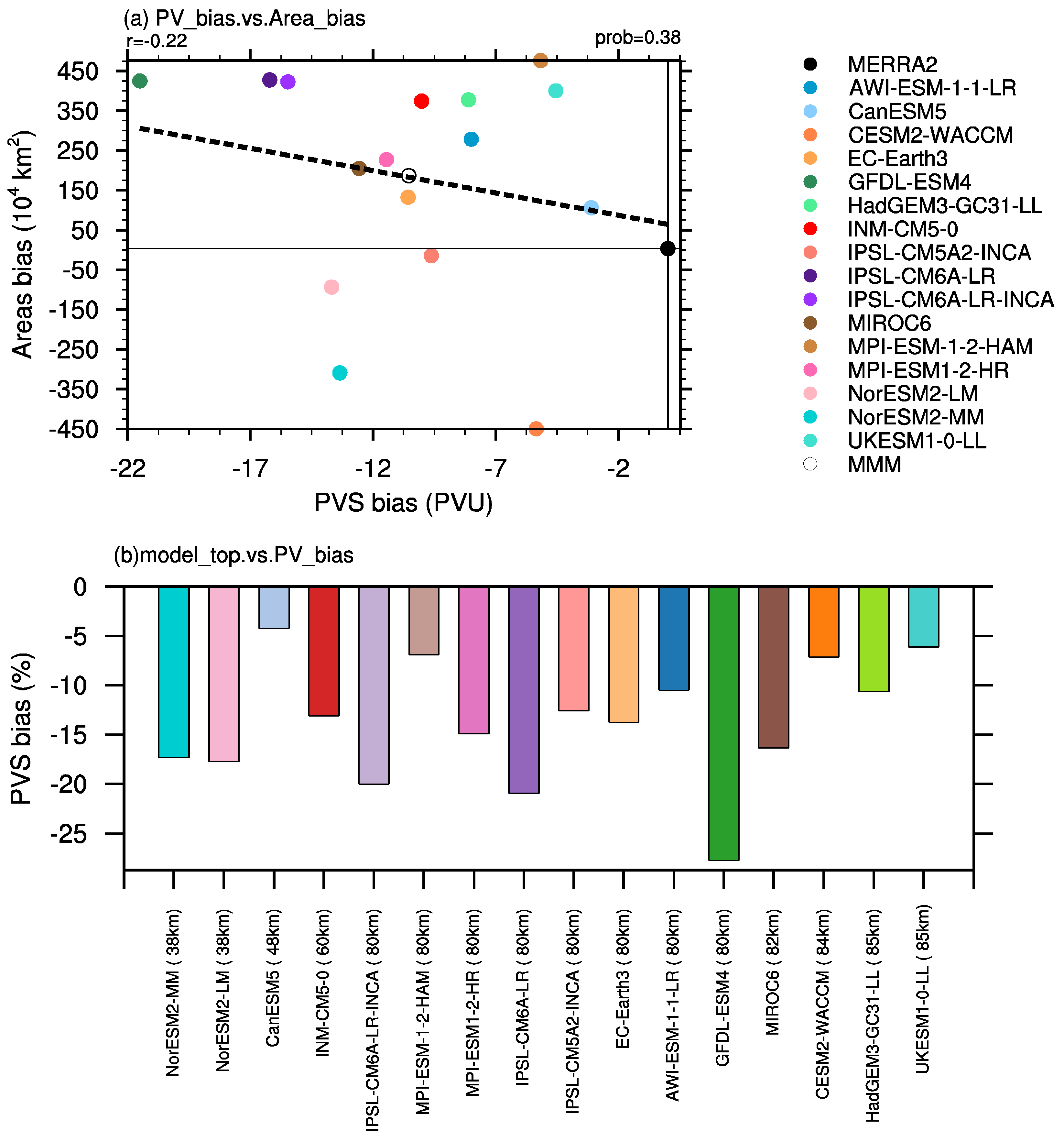


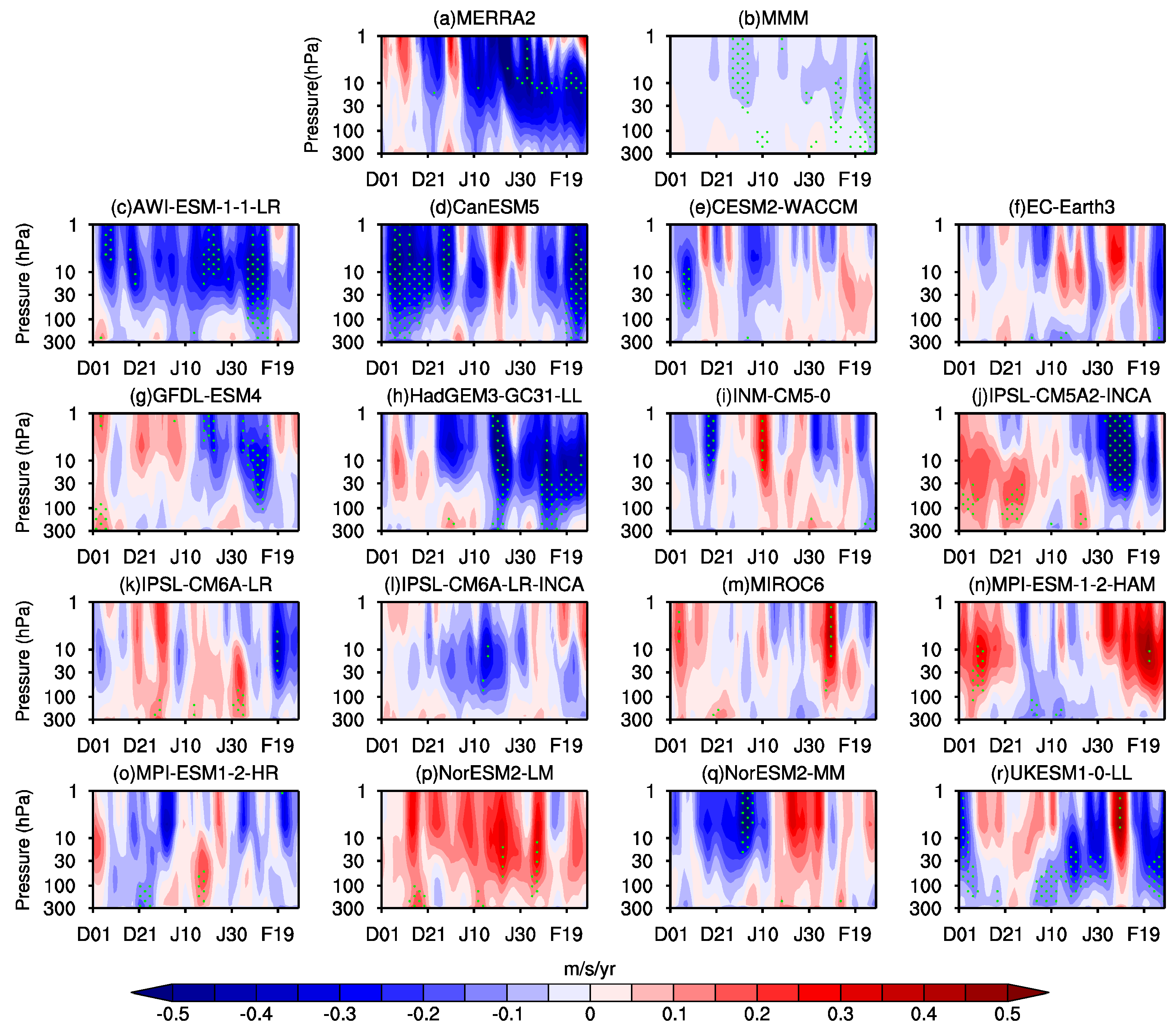
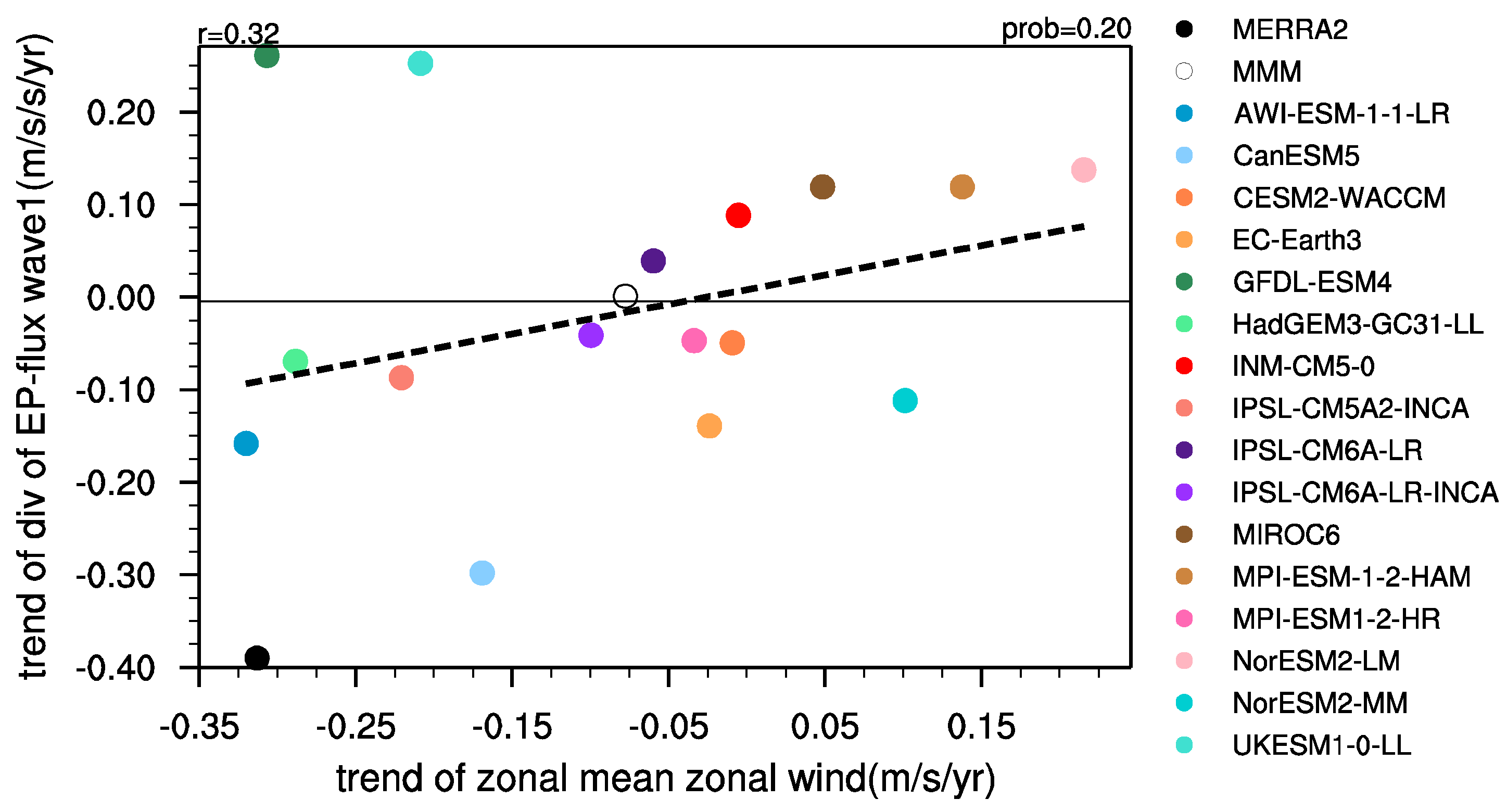

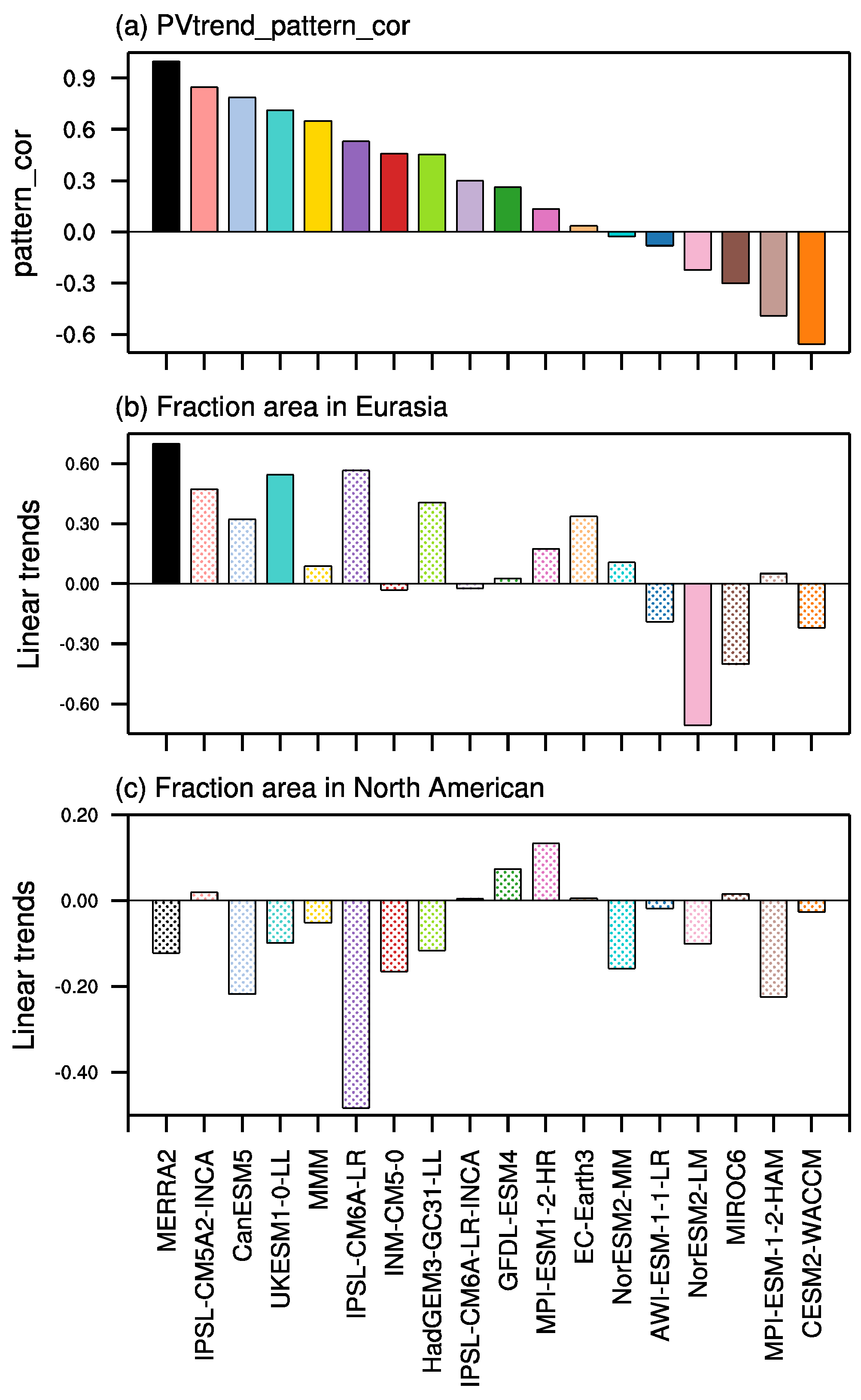
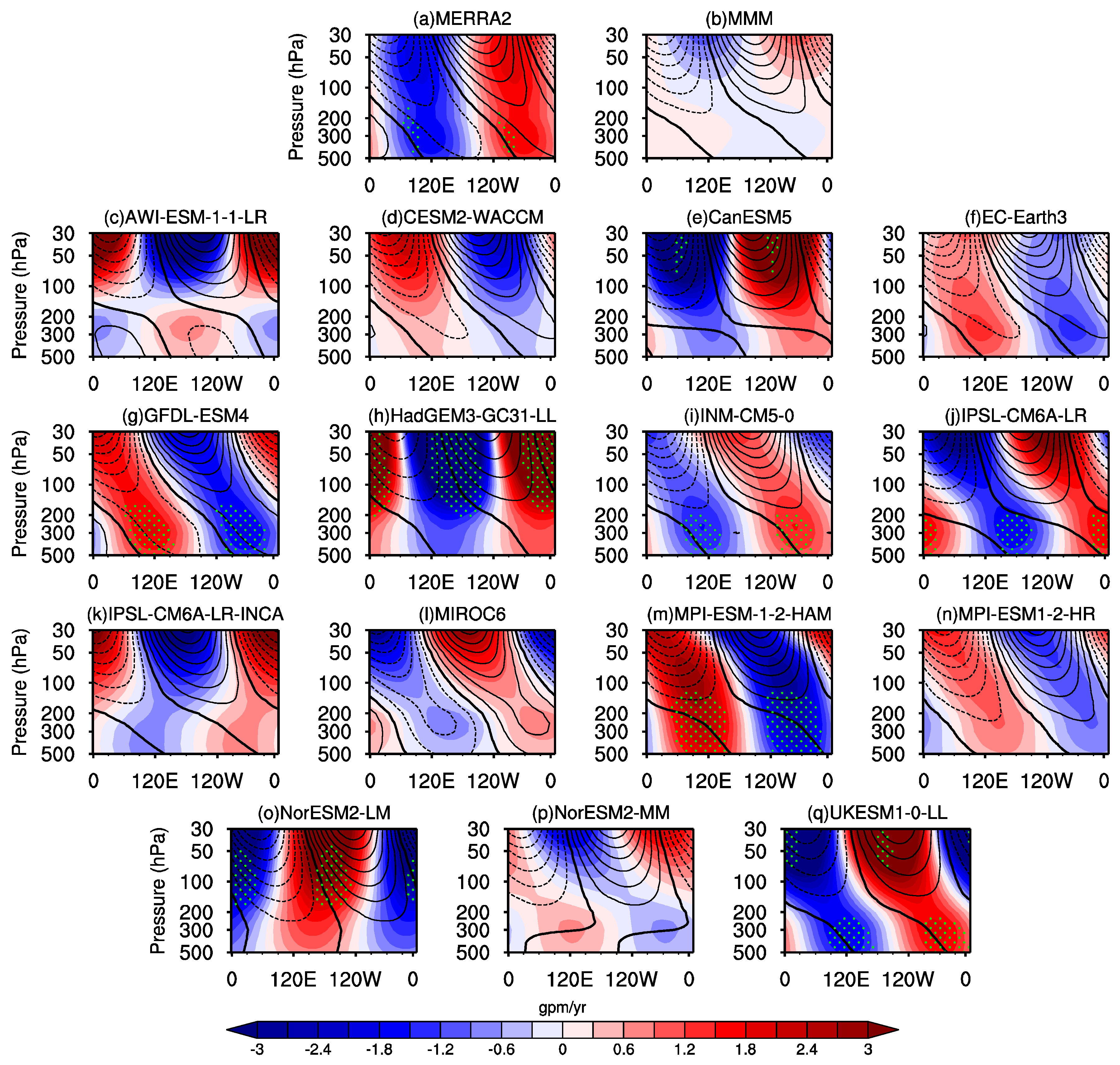
| Model | Resolution | Stratospheric Chemistry | The Meteorological Fields | Datasets |
|---|---|---|---|---|
| AWI-ESM-1-1-LR | 192 × 96 longitude–latitude; 47 levels; top level 80 km | Prescribed (CMIP6 dataset) | Historical | Danek et al. [44] |
| CanESM5 | 128 × 64 longitude–latitude; 49 levels; top level 1 hPa | Prescribed (other) | Historical | Swart et al. [45] |
| CESM-WACCM | 288 × 96 longitude–latitude; 70 levels; top level 4.5 × 10−6 hPa | Interactive chemistry | Historical | Danabasoglu [46] |
| EC-Earth3 | 512 × 256 longitude–latitude; 91 levels; top level 0.01 hPa | Prescribed (CMIP6 dataset) | Historical | EC-Earth Consortium [47] |
| GFDL-ESM4 | 360 × 180 longitude–latitude; 49 levels; top level 0.01 hPa | Interactive chemistry | Historical | Krasting et al. [48] |
| HadGEM3-GC31-LL | 192 × 144 longitude/latitude; 85 levels; top level 85 km | Prescribed (CMIP6 dataset) | Historical | Ridley et al. [49] |
| INM-CM5-0 | 180 × 120 longitude/latitude; 73 levels; top level sigma = 0.0002 (~0.2 hPa) | Prescribed (CMIP6 dataset) | Historical | Volodin et al. [50] |
| IPSL-CM5A2-INCA | 96 × 96 longitude/latitude; 39 levels; top level 80 km | Interactive chemistry | Historical | Boucher et al. [51] |
| IPSL-CM6A-LR | 144 × 143 longitude–latitude; 79 levels; top level 80 km | Prescribed (CMIP6 dataset) | Historical | Boucher et al. [52] |
| IPSL-CM6A-LR-INCA | 144 × 143 longitude/latitude; 79 levels; top level 80 km | Prescribed (CMIP6 dataset) | Historical | Boucher et al. [53] |
| MIROC6 | 256 × 128 longitude/latitude; 81 levels; top level 0.004 hPa | Prescribed (CMIP6 dataset) | Historical | Tatebe et al. [54] |
| MPI-ESM-1-2-HAM | 192 × 96 longitude–latitude; 47 levels; top level 0.01 hPa | Interactive chemistry | Historical | Neubauer et al. [55] |
| MPI-ESM1-2-HR | 384 × 192 longitude–latitude; 95 levels; top level 0.01 hPa | Prescribed (CMIP6 dataset) | Historical | Jungclaus et al. [56] |
| NorESM2-LM | 144 × 96 longitude–latitude; 32 levels; top level 3 hPa | Prescribed (other) | Historical | Seland et al. [57] |
| NorESM2-MM | 288 × 192 longitude–latitude; 32 levels; top level 3 hPa | Prescribed (other) | Historical | Bentsen et al. [58] |
| UKESM1-0-LL | 192 × 144 longitude–latitude; 85 levels; top level 85 km | Interactive chemistry | Historical | Tang et al. [59] |
| Model | PV Center | Areas (104 km2) | Area Bias (%) (vs. ERA-I) | Area Bias (%) (vs. MERRA2) | The Polar Vortex Strength | The Bias of Polar Vortex Strength (%) (vs. ERA-I) | The Bias of Polar Vortex Strength (%) (vs. MERRA2) |
|---|---|---|---|---|---|---|---|
| ERA-I | (80.37°N, 31.77°E) | 2085.79 | 0 | −2.60 | 78.7 | 0 | 0.56 |
| MERRA2 | (80.44°N, 32.25°E) | 2141.54 | 2.67 | 0 | 78.2 | −0.56 | 0 |
| AWI-ESM-1-1-LR | (82.76°N, 33.08°E) | 2416.54 | 15.86 | 12.84 | 70.2 | −10.75 | −10.25 |
| CanESM5 | (80.65°N, 34.56°E) | 2244.16 | 7.59 | 4.79 | 75.1 | −4.53 | −4.00 |
| CESM-WACCM | (80.23°N, 36.39°E) | 1688.08 | −19.07 | −21.17 | 72.9 | −7.38 | −6.87 |
| EC-Earth3 | (82.23°N, 24.10°E) | 2270.43 | 8.85 | 6.02 | 67.6 | −14.02 | −13.54 |
| GFDL-ESM4 | (83.18°N, 10.33°E) | 2562.83 | 22.87 | 19.67 | 56.7 | −27.92 | −27.51 |
| HadGEM3-GC31–LL | (81.18°N, 41.30°E) | 2515.47 | 20.60 | 17.46 | 70.1 | −10.89 | −10.39 |
| INM-CM5-0 | (84.06°N, 28.38°E) | 2512.17 | 20.44 | 17.31 | 68.2 | −13.32 | −12.83 |
| IPSL-CM5A2-INCA | (82.51°N, 5.44°E) | 2123.78 | 1.82 | −0.83 | 68.6 | −12.82 | −12.33 |
| IPSL-CM6A-LR | (80.53°N, 5.51°E) | 2565.55 | 23.00 | 19.80 | 62.0 | −21.19 | −20.75 |
| IPSL-CM6A-LR-INCA | (81.61°N, 4.31°E) | 2560.84 | 22.78 | 19.58 | 62.7 | −20.24 | −19.80 |
| MIROC6 | (82.22°N, 14.94°E) | 2342.82 | 12.32 | 9.40 | 65.6 | −16.56 | −16.09 |
| MPI-ESM-1-2-HAM | (82.90°N, 31.61°E) | 2614.31 | 25.34 | 22.08 | 73.0 | −7.15 | −6.63 |
| MPI-ESM1-2-HR | (80.18°N, 32.04°E) | 2365.23 | 13.40 | 10.45 | 66.8 | −15.14 | −14.67 |
| NorESM2-LM | (78.58°N, 43.81°E) | 2044.62 | −1.97 | −4.53 | 64.5 | −17.98 | −17.52 |
| NorESM2-MM | (78.43°N, 29.12°E) | 1829.03 | −12.31 | −14.59 | 64.9 | −17.56 | −17.10 |
| UKESM1-0-LL | (81.76°N, 36.10°E) | 2538.13 | 21.69 | 18.52 | 73.7 | −6.36 | −5.84 |
| Multi-model mean | (82.26°N, 26.83°E) | 2324.62 | 11.45 | 8.55 | 67.7 | −13.99 | −13.51 |
Publisher’s Note: MDPI stays neutral with regard to jurisdictional claims in published maps and institutional affiliations. |
© 2022 by the authors. Licensee MDPI, Basel, Switzerland. This article is an open access article distributed under the terms and conditions of the Creative Commons Attribution (CC BY) license (https://creativecommons.org/licenses/by/4.0/).
Share and Cite
Zhao, S.; Zhang, J.; Zhang, C.; Xu, M.; Keeble, J.; Wang, Z.; Xia, X. Evaluating Long-Term Variability of the Arctic Stratospheric Polar Vortex Simulated by CMIP6 Models. Remote Sens. 2022, 14, 4701. https://doi.org/10.3390/rs14194701
Zhao S, Zhang J, Zhang C, Xu M, Keeble J, Wang Z, Xia X. Evaluating Long-Term Variability of the Arctic Stratospheric Polar Vortex Simulated by CMIP6 Models. Remote Sensing. 2022; 14(19):4701. https://doi.org/10.3390/rs14194701
Chicago/Turabian StyleZhao, Siyi, Jiankai Zhang, Chongyang Zhang, Mian Xu, James Keeble, Zhe Wang, and Xufan Xia. 2022. "Evaluating Long-Term Variability of the Arctic Stratospheric Polar Vortex Simulated by CMIP6 Models" Remote Sensing 14, no. 19: 4701. https://doi.org/10.3390/rs14194701





